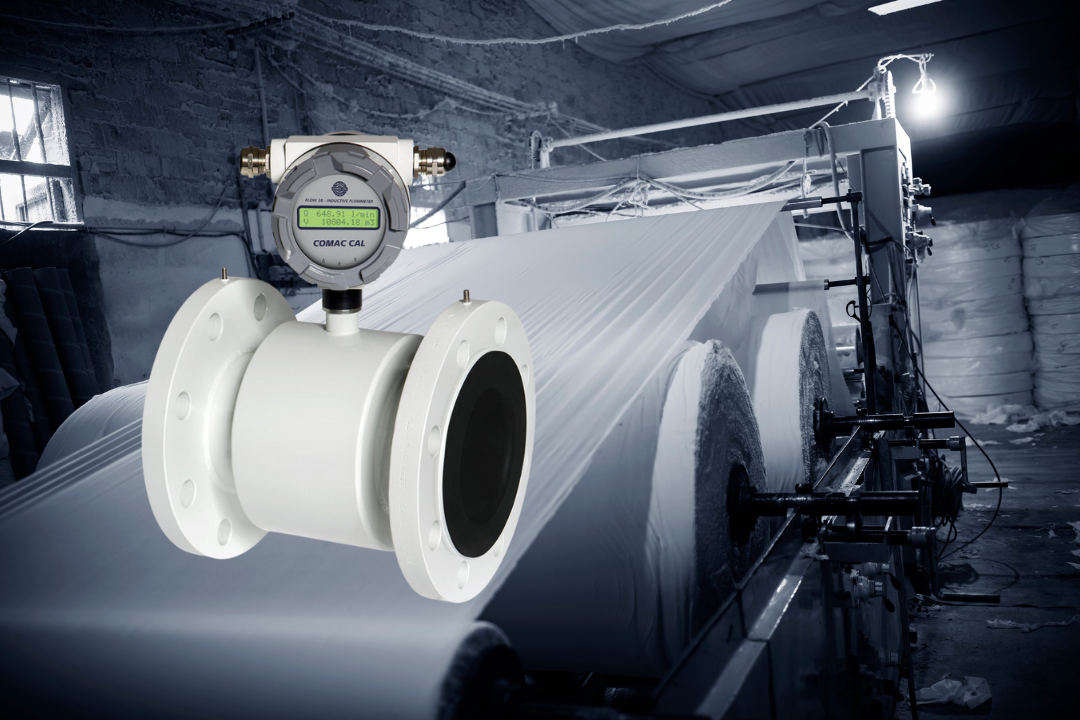Measuring Flow of Pulp Slurry and Paper Stock
The pulp and paper industry faces several challenges that directly impact production efficiency, product quality, and operational costs. These challenges stem from the complex nature of handling pulp slurry, which is a mixture of water and fibrous materials. Electromagnetic flow meters, or magnetic flow meters, are particularly well-suited to address these challenges and measure flow of pulp reliably, offering solutions that improve accuracy, reduce maintenance, and optimize processes. This article explores how magnetic flow meters are applied in this industry, focusing on their benefits, operation, and the specific challenges they address.
Understanding Pulp Slurry and Paper Stock
Pulp slurry and paper stock are mixtures of water and fibrous materials, such as wood or recycled paper, used in the production of paper products. Accurately measuring flow of pulp slurry is a critical parameter in the papermaking process. Pulp slurry typically contains around 2% to 6% solid content, while paper stock can range from very dilute to thicker mixtures as the production process progresses.
Accurate flow measurement of these mixtures is essential for several reasons:
- Quality Control: Ensuring the correct proportion of water to fibers affects the final product’s strength, texture, and appearance.
- Process Efficiency: Optimal flow rates help prevent blockages, reduce downtime, and maximize throughput.
- Resource Management: Accurate flow measurement aids in controlling water and chemical usage, minimizing waste, and reducing costs.
The Role of Magnetic Flow Meters in Measuring Flow of Pulp
Magnetic flow meters excel in measuring flow of pulp slurries with varying consistencies. Since they operate based on the principle of electromagnetic induction, their accuracy is not influenced by the physical properties of the slurry, such as density or viscosity. This ability ensures consistent and precise measurements, regardless of changes in the slurry composition, leading to better control over the papermaking process.
The FLOW 38 magnetic flow meter offers an ideal solution for measuring the flow of pulp slurry, thanks to its ability to maintain accuracy in demanding environments. Its robust construction and ease of integration into existing systems make it a valuable asset in any pulp and paper production process. Discover how the FLOW 38 can enhance your operations here.
Key Benefits of Using Magnetic Flow Meters:
- Non-Intrusive Measurement: Magnetic flow meters are non-intrusive, meaning they have no moving parts that come into contact with the slurry or paper stock. This design reduces wear and tear, extends the meter’s lifespan, and minimizes maintenance requirements. The absence of obstructions in the flow path also reduces the risk of blockages, which is particularly important when measuring pulp slurry with high solid content.
- Accuracy and Repeatability: Magnetic flow meters are known for their high accuracy and repeatability, even in challenging conditions. They can maintain consistent performance over a wide range of flow rates and slurry consistencies. This accuracy is crucial in the pulp and paper industry, where even minor variations in flow can impact product quality and process efficiency.
- Suitability for Slurry Measurement: The ability of magnetic flow meters in measuring flow of pulp slurries makes them particularly well-suited for measuring the flow of pulp slurry and paper stock. Unlike some other flow measurement technologies, magnetic flow meters are not affected by the presence of suspended solids or changes in slurry density, making them reliable in these demanding applications.
- Minimal Pressure Loss: Since magnetic flow meters have no moving parts or obstructions in the flow path, they cause minimal pressure loss. This feature is beneficial in processes where maintaining consistent pressure is critical for operational efficiency.
- Ease of Integration: Magnetic flow meters are easy to integrate into existing process control systems. They offer various output options, such as 4-20 mA signals, which can be used for real-time monitoring and control of flow rates. This integration capability allows operators to optimize the papermaking process and respond quickly to any deviations from the desired flow conditions.
Challenges and Considerations for Accurately Measuring Flow of Pulp
While magnetic flow meters offer numerous advantages, there are a few challenges and considerations to keep in mind when using them in the pulp and paper industry:
- Installation: Proper installation is critical to ensure accurate measurements. Magnetic flow meters should be installed in sections of the pipeline where the flow is stable and free from turbulence or air bubbles. Incorrect installation can lead to measurement errors.
- Conductivity: Magnetic flow meters require the fluid being measured to be conductive. Fortunately, pulp slurry and paper stock typically meet this requirement, but it’s essential to ensure that the conductivity is within the meter’s operating range.
- Calibration: Regular calibration and maintenance are necessary to ensure long-term accuracy. While magnetic flow meters are generally low-maintenance, periodic checks help identify any potential issues before they affect the measurement process.
Ready to Optimize Flow Measurement of Pulp?
In the pulp and paper industry, measuring flow of pulp slurry and paper stock is a critical task that directly impacts product quality, process efficiency, and resource management. Magnetic flow meters offer an accurate, reliable, and low-maintenance solution for this challenging application. Their ability to handle slurry mixtures, combined with their non-intrusive design and ease of integration, makes them an indispensable tool in the production of high-quality paper products.
As the industry continues to evolve, the adoption of advanced flow measurement technologies like magnetic flow meters will play a crucial role in optimizing processes and ensuring sustainable operations. By investing in the right flow measurement solutions, pulp and paper manufacturers can achieve greater control over their processes, reduce waste, and deliver consistent, high-quality products to the market.


